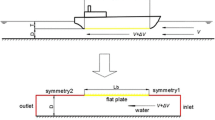Abstract
A new method is proposed to correct shallow-water model resistance tests for the effect of the tank side walls, i.e. to correct the resistance curve towards shallow water of infinite width. From computed flow fields along ships in shallow water and channels, the tank or channel walls are found to increase the overspeed along the ship (return flow) by an amount that is roughly constant over the channel section. An algebraic equation is derived from which this amount can be solved, using a volume flux derived from a single potential-flow computation. The effect of the tank walls on the resistance curve is represented by a speed shift corresponding with this overspeed. The assumptions made are checked against computed flow fields and resistances. The overspeed increment is very well predicted; its effect on the resistance is fairly well estimated as long as it is not too strong. The method, in routine use for shallow-water tests at MARIN, is most practical; and in view of the large tank wall effects in shallow water, it is essential for good predictions.



















Similar content being viewed by others
References
ITTC (2008) 1978 ITTC performance prediction method. Recommended Procedures and Guidelines, 7.5-02
Raven HC (2012) A computational study of shallow-water effects on ship viscous resistance. In: 29th Symposium on naval hydrodynamics, Gothenburg, Sweden
Kreitner J (1934) Über den Schiffswiderstand auf beschränktem Wasser. Werft, Reederei, Hafen, 15–7, pp 77–82
Schuster S (1956) Beitrag zur Frage der Kanalkorrektur bei Modellversuchen. Schiffstechnik Bd:3
Schlichting O (1934) Schiffswiderstand auf beschränkter Wassertiefe—Widerstand von Seeschiffen auf flachem Wasser. STG Jahrbuch 35
Emerson A (1959) Ship model size and tank boundary correction. Trans NECES:251
Kirsch M (1966) Shallow water and channel effects on wave resistance. J Ship Res 10:164–181
Tamura K (1972) Study on the blockage correction. J Soc Naval Arch Jpn 131:17
Scott JR (1975) Blockage correction at sub-critical speeds. Trans R Inst Naval Arch 118:169
ITTC (2002) Testing and extrapolation methods—resistance test. ITTC Recommended Procedures 75-02-02-01
Artjushkov LS (1968) Wall effect correction for shallow water model tests. NE Coast Inst Trans 85:2
Landweber L (1939) Tests of a model in restricted channels. US Exp. Model Basin Report No. 460
ITTC Resistance Committee (1990) Final report and recommendations to the 19th ITTC. 19th international Towing Tank conference, Madrid
ITTC Resistance Committee (1993) Final report and recommendations to the 20th ITTC. 20th International Towing Tank conference, San Francisco, USA
Schijf JB (1949) Protection of embankments and bed in inland and maritime waters, and in overflow or weirs. XVII international Navigation Congress, Lisbon
Larsson L, Raven HC (2010) Ship resistance and flow. Principles of Naval Architecture Series, SNAME, Jersey City
Raven HC (1996) A solution method for the nonlinear ship wave resistance problem. PhD Thesis, Delft University of Technology
Raven HC (1992) A practical nonlinear method for calculating ship wavemaking and wave resistance. 19th symposium on naval hydrodynamics, Seoul, Korea
Vaz G, Jaouen F, Hoekstra M (2009) Free-surface viscous flow computations. Validation of URANS Code FRESCO. In: Proceedings of OMAE2009, Honolulu, Hawaii, USA
Tuck EO (1967) Sinkage and trim in shallow water of finite width. Schiffstechnik Bd 14:73
Lataire E, Delefortrie G, Vantorre M (2016) Impact of banks on ship squat. 4th MASHCON conference, Hamburg, Germany
Acknowledgements
This research was partly funded by the Dutch Ministry of Economic Affairs. The contribution is gratefully acknowledged.
Author information
Authors and Affiliations
Corresponding author
Appendix: Derivation of equation for overspeed increment in a channel
Appendix: Derivation of equation for overspeed increment in a channel
The cross section available to the flow at the midship location is determined by the nominal channel cross section AC, minus the ship’s nominal midship sectional area AM = β AC, minus the area reduction due to the drop of the water level Δh, minus the effect of the dynamic sinkage of the vessel:
1.1 Shallow, infinitely wide water
The overspeed ratio is \(\gamma =\gamma (y,z)\). The volume flux through the area inside the channel wall locations at the midship section, is:
The last term is the volume flux lost due to the midship sectional area of the hull multiplied by the local flow speed. The sinkage of the vessel is supposed to be in agreement with the local flow speed at the midship section, and is, therefore, absorbed in the integral.
1.2 Shallow channel
For this case, a larger flux (increased by Qout) needs to pass by the area inside the channel walls, but also the resulting larger overspeed causes a further drop of the water level and increased sinkage. The additional overspeed \(\Delta \gamma =\Delta {u_{{\text{channel}}}}{\text{/}}V\) is supposed to be uniformly distributed, Eq. 7. If again we suppose the increased sinkage of the vessel to correspond with the local overspeed, we can write the volume flux through the channel:
The difference between the flux through the channel, and that through the same area for shallow water, then is:
where \(\bar {\gamma }\) is the mean overspeed at the water surface over the channel width, in shallow water. We notice a term quadratic in \(\gamma (y,0)\) that would prevent a further simplification. However, as the overspeed ratio in typical cases is just somewhat larger than 1 and decreases gradually to 1 over a distance larger than the typical channel width, we approximate it by the square of the mean overspeed.
This difference of the volume flux equals the excess volume flux passing outside the channel wall locations for the shallow-water case:
Substituting and dividing by AC we arrive at the following third-degree equation for ∆γ:
About this article
Cite this article
Raven, H.C. A method to correct shallow-water model tests for tank wall effects. J Mar Sci Technol 24, 437–453 (2019). https://doi.org/10.1007/s00773-018-0563-1
Received:
Accepted:
Published:
Issue Date:
DOI: https://doi.org/10.1007/s00773-018-0563-1




